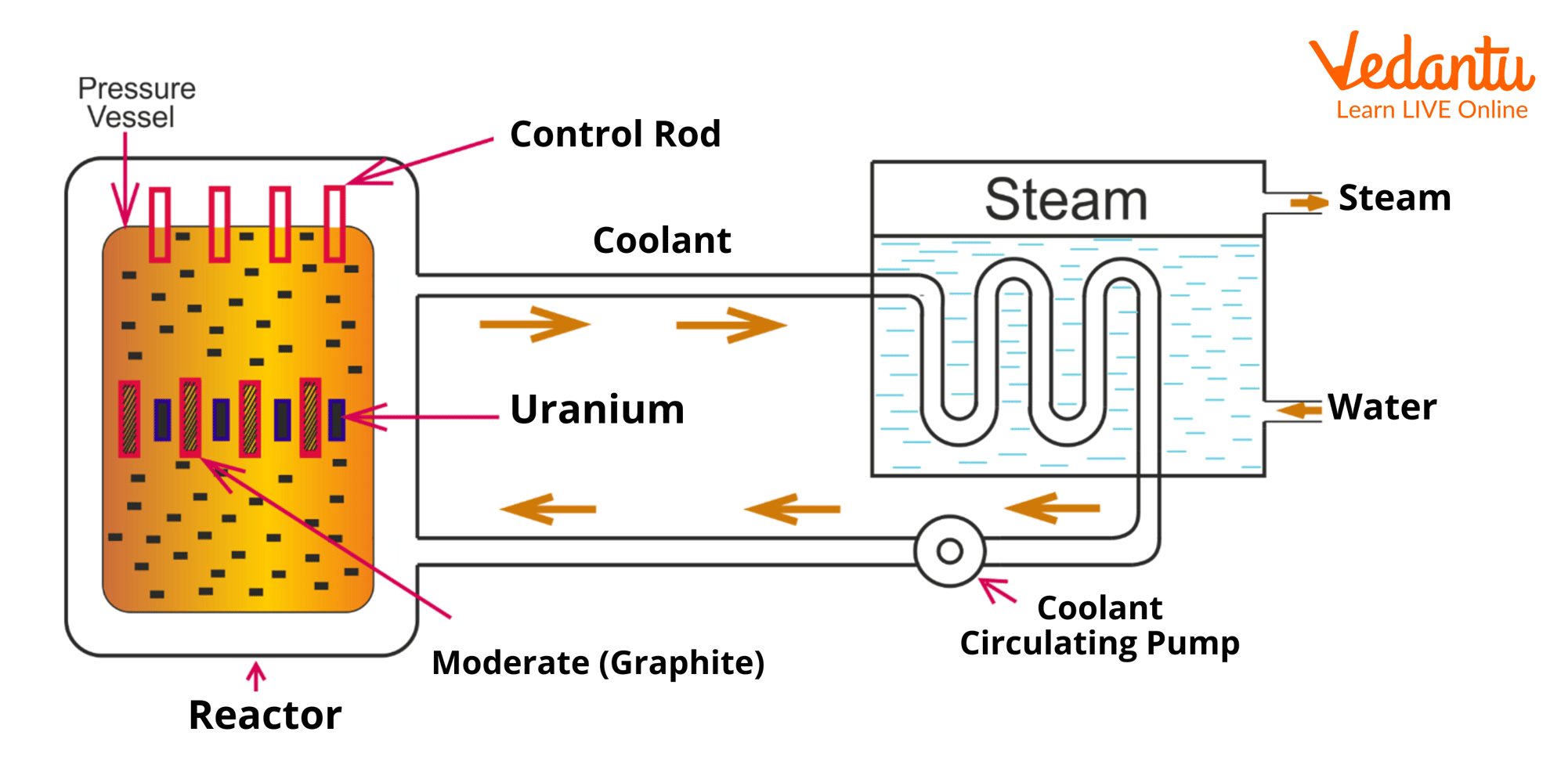




What is a Nuclear Reactor?
Nuclear reactors are the devices which can initiate and control neutron-induced nuclear fission reactions. A nuclear reactor definition can be “It is a reactor which controls the chain reactions initiated by bombarding large fissile atomic nuclei such as Uranium-
Working Principle of Nuclear Reactor
The fissile atomic nuclei like uranium-
Conversion of kinetic energy produced by fission products to thermal energy when these products collide with nearby atoms.
The gamma rays produced during fission get absorbed by the reactor and produce heat.
Heat is also produced during the fission chain reaction.
A kilogram of uranium-
Reactions
As an example, we can see the fission reaction of Uranium-
The products of fission are radioactive nuclei and they emit
As we can see the extra neutrons released during the fission reaction, in turn, initiates another fission reaction, producing more neutrons, and so on. This leads to a chain reaction. This chain reaction happens in a nuclear reactor but in a controlled manner. The uncontrolled chain reaction leads to an explosion, e.g., the nuclear bomb.
Construction of Nuclear Reactor
The components of a nuclear reactor are,
Fuel Rods: Nuclear fuel is the fissionable material used in nuclear reactors for conducting nuclear fission reactions to produce energy. Uranium enriched with
Moderator: The fast-moving neutrons produced, initiates an uncontrollable chain reaction in a nuclear reactor. Moderators are connected along with the fissionable nuclei for slowing down fast neutrons. They are molecules like water, heavy water, graphite and deuterium. As we can see the coolant like water also can act as a neutron moderator. A moderator causes the fast neutrons to lose energy and become thermal neutrons. Thermal neutrons cannot start a fission reaction.
Control Rods: Rods of boron or cadmium are inserted inside the reactor to capture the slow neutrons which cause further fission reaction. The slow neutrons lead to a violent chain reaction. These rods are called control roads.
Coolant: The heat energy produced during the fission reaction in a nuclear reactor is transferred to the coolant. The coolant then gets heated and it transfers this energy to water in a heat exchanger and the generated steam is then used to produce electricity. In coolants used are liquid sodium metal, carbon dioxide gas or water.
Shielding: The whole reactor is shielded using

Nuclear Reactor Uses
The following are the some of the nuclear reactor uses,
The main application of nuclear reaction is in energy production in the form of electricity.
The energy produced in this reactor is used for propulsion in vehicles such as submarines or naval vessels, rockets etc.
The heat generated is also used for desalination, industrial heating, hydrogen production etc.
Radioactive isotopes, like americium (used in smoke detectors), cobalt-
Weapons-grade plutonium used in nuclear weapons is produced in nuclear reactors.
Nuclear Reactors are used to generate neutron beams of high intensity. This neutron beam is used for the treatment of cancer and for nuclear research.
Conclusion
The nuclear reactor, are reactors which can initiate and control a self-sustaining chain of nuclear fission reactions. Nuclear reactors are used mainly for electricity generation, energy sources, production of radioactive isotopes etc. The initial capital cost for the building of nuclear reactors is very high. But they produce large amounts of energy in a small volume of fuel. Proper safety measures and control of such reactors are very essential. The major catastrophic accident happened in the Chernobyl reactor in Ukraine in 1986. The nuclear wastes generated, need special treatment techniques and disposal methods, as they are radioactive and hazardous.






FAQs on Nuclear Reactor - JEE Main Important Topic
1. What is the Critical Mass of nuclear fissionable material?
It is the smallest amount of fissionable material required for a sustained nuclear chain reaction. If a nuclear chain reaction happening in a mass of fissile material is self-sustaining, then the mass is said to be in a critical state. In such a case, there will be no increase or decrease in power, temperature, or neutron population.
2. What is nuclear fusion?
Nuclear fusion is a type of nuclear reaction in which two light nuclei combine to form a heavier one. For fusion to occur, two nuclei must come close enough so that the attractive short-range nuclear force is able to affect them.
3. What are the different types of nuclear reactions?
The number of likely nuclear reactions is huge, some types of major nuclear reactions are Elastic scattering, Inelastic scattering, Capture reactions, Transfer reactions, Fission reactions, Fusion reactions and nuclear decay.










